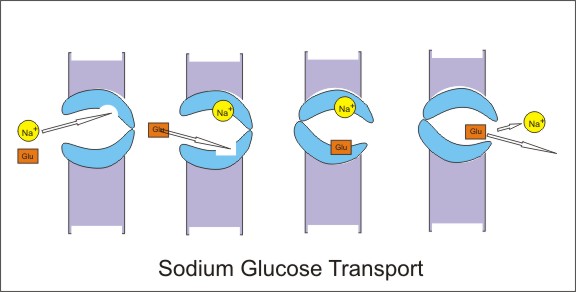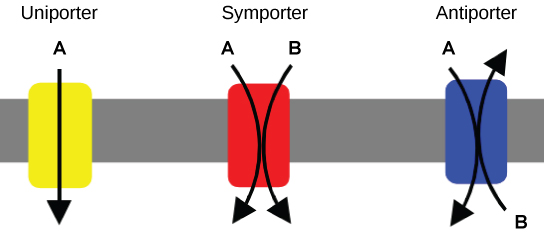Facilitated diffusion is the process of movement of ions from higher concentration to their lower concentration with the help of carrier proteins via a membrane. In a biological system, the movement of simpler molecules can occur through a selectively permeable membrane. It can transports glucose, amino acids and other substances. Let’s focus on the facilitated diffusion example:
Proteins are transporting the elements from either side of the plasma membrane. These transport proteins are of three types depending upon what type of molecule they carried. Carrier proteins, gated-channel proteins and channel proteins.

Image credit: Wikimedia commons

Image credit: Wikimedia commons
Glucose transport
As it is a very common carbs and a great source of energy required for proper metabolism in a living system. It should be transported and distributed in the proper amount to all the cells as per their need. The glucose transporters are present in the intracellular pool of the cellular membrane which facilitates the uptake of glucose molecules by the cells.
Glucose transporters are of 2 types:
1. Glucose Transporters (GLUT1, GLUT-2, GLUT-3, GLUT-4————–GLUT-14)
2. Sodium-Glucose Linked Transporter (SGLTs)
GLUTs are present mainly in four regions like brain cells, intestinal walls, adipose tissues, and skeletal and cardiac muscles where SGLTs are supporter proteins and transport the molecules in the same directions.

Image credit: Wikimedia commons
Say for example,
In the intestinal region, two barriers are present for the transportation i.e. Epithelial barrier and the Baso-lateral membrane. Sodium-coupled receptors are present over the apical membrane, nearby sodium ions bind up with these receptors which also facilitates the entry of glucose molecules inside the membrane. Then the low concentration of potassium ions inside the basolateral region results in the efflux of Na+ ions inside the cells through Na+-K+ ATPase. Consequently, glucose molecules are also absorbed into the systemic circulation.
Amino acid transport
Amino acid gets transported by channel proteins. They are present on the plasma membrane of the blood-brain barrier. They bind up with the receptors/channels and move across the membrane i.e. from extracellular fluid to intracellular fluid and vice-versa. Some of the amino acids are more specific to gated-channel proteins and facilitated the movement in both directions.

Image credit: Wikimedia commons
They have two different sodium-independent transporter systems :L and y+ transporter systems.
While few polypeptide chains are bulky in shape that’s why transported through the facilitative transporters and are Na+-K+ ATPase-dependent. They work according to the concentration gradient.
Water transport
Water can be easily transported by the process of simple diffusion. But sometimes, they also need selective-carrier proteins to pass through this semi-permeable membrane and are dependent upon the electrochemical potential. So, this aquatransporter are known as aquaporins embedded in the phospholipid bilayer.

Image credit: Wikimedia commons
Aquaporins are a family of small endogenous membrane proteins (24-30 kDa) found in mammalian cells and can effectively increase the overall rate of water movement across cell membranes. They have 10 isoforms from AQP1 to AQP10. Although they also provide a gateway for small solutes like glycerol, urea, CO2 etc and are known as aqua glyceroporins.
Gas transport
Necessary gases are transported through the integral carrier proteins via a semi-permeable membrane. As CO2, O2, NH3 and other gases can be transported by simple diffusion but some of the cellular membranes are impermeable for absorption so they need an efficient carrier protein for entry and exit of the gaseous molecules.
Gaseous exchange in higher organisms is an important facilitated diffusion example. In blood, the carrier protein is haemoglobin, while in muscle, the carrier protein is myoglobin. This occurs due to the pressure differences through both sides of the membrane.
In unfavourable conditions, gases like CO2 are also carried by aquaporins. Initially, a non-haemoglobin carrier protein is used to carry these gases and was named Rhesus proteins (Rh proteins) but as the time passes, after a lot of studies, it is named aquaporins. Different AQPs ligate with different gases.
Ion transport
Ions are also diffusing across the membrane as per the balancing of membrane potential. Passive transport of ions along the electrochemical gradient is primarily mediated by ion channels and exhibits selective ion permeability, so the ion gradient creates a potential difference (membrane voltage) throughout the cell membrane.
The resting membrane potential of most cells is primarily determined by the equilibrium K+ potential, which is negative for extracellular fluid. Ions are polar molecules and cannot move across similarly charged membranes.
This facilitated diffusion is a passive process but ions can be actively transported too at the expenditure of energy, involving secondary ion pumps also known as active transporters. These ion transporters are selective for K+, Na+, Ca2+, H+, Cl−, cations or anions. Ex- ABC transporter.
Ion transporters are having three properties-
- Ions pass via channels are extraordinarily rapid. More than one million can move from these open channels.
- These channels are highly specific for a particular size of ions, as the size of ions is directly proportional to the size of integral proteins.
- Most ion channels are not permanently open as they play a vital role in the transmission and regulation of electric impulses across the membrane.
Higher levels of ion selectivity are indicated by voltage-gated Na+ and K+ channels. Na+ channels are more than 10 times more permeable to Na+ than K+, and K+ channels are more than 1000 times more permeable to K+ than Na+. Voltage-gated channels are mediated with the aid of using one of the transmembrane α-helices containing numerous charged amino acids.
Membrane depolarization induces the extracellular transfer of these positive charges, shifting the location of this transmembrane segment and opening channels. The rapid inactivation of Na+ and K+ channels during action potential propagation is then mediated by the cytoplasmic portion of the polypeptide chain that binds to the cytoplasmic portion of the channels.
Ion transporters are of three types through which ions gets in the intracellular space as per the directions provided by them.
1. Symporter
2. Antiporter
3. Uniporter

Image credit: Wikimedia commons
Conclusion
I have concluded my words with that facilitated diffusion is the passive transport of the larger molecules with the help of surface protein which cannot be transported by simple diffusion. Some glucose molecules, polypeptide chains and ions are carried by this process across the membrane without the expenditure of ATP molecules.
Also Read:
- Ankle anatomy
- Antiparallel dna strands 2
- How are nucleotides produced
- Do red blood cells have a cell wall
- Filamentous bacteria examples
- Is mitochondria the powerhouse of the cell
- Is cell membrane an organelle
- Aquatic biome examples
- Do plant cells have mitochondria
- Meiosis stages 2

Hi….I am Anushree Verma, I have completed my Master’s in Biotechnology. I am a very confident, dedicated and enthusiastic author from the biotechnology field. I have a good understanding of life sciences and great command over communication skills. I thrive to learn new things every day. I would like to thank this esteemed organization for giving me such a great opportunity.
Let’s connect through LinkedIn- https://www.linkedin.com/in/anushree-verma-066ba7153